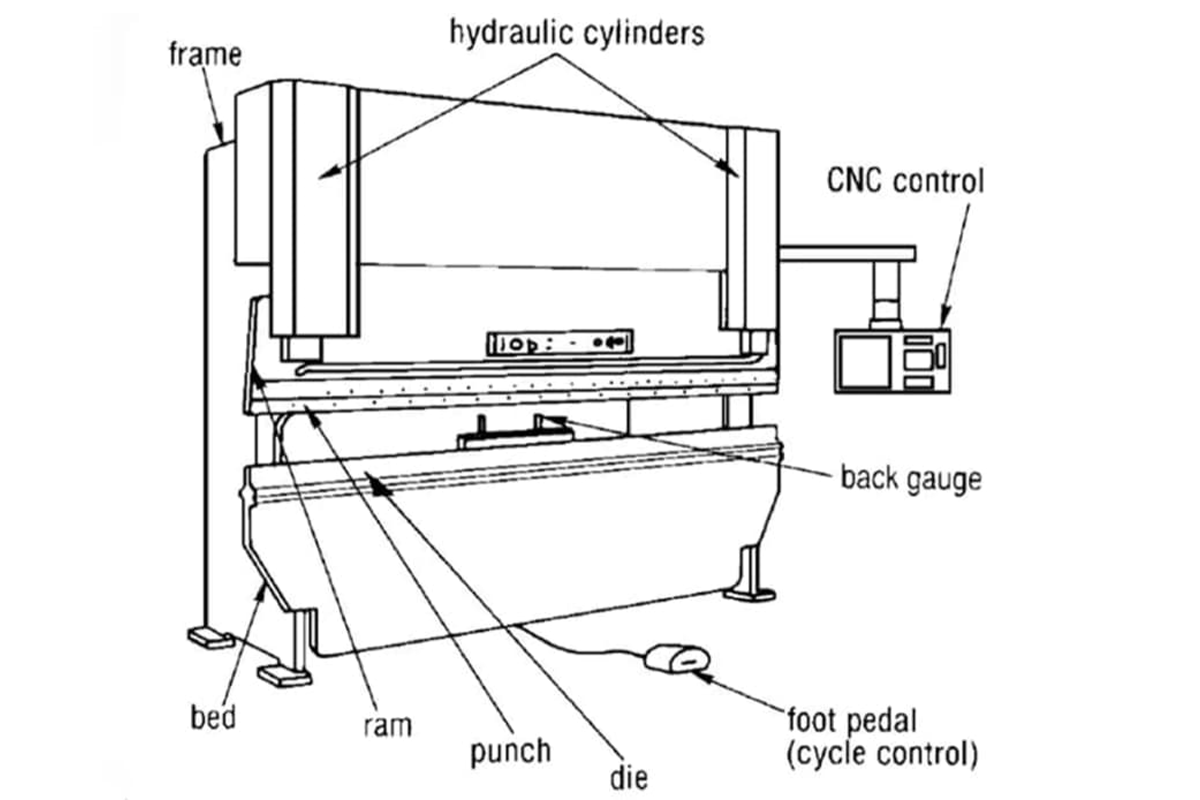Press Brake Frame: The Foundation of Precision and Stability
The frame of a press brake is more than just a structural element — it is the foundation of the machine’s accuracy, strength, and long-term reliability. As a supplier of high-quality press brake components, we understand the critical importance of a well-designed and robust frame in achieving optimal bending performance, consistent accuracy, and long service life. This article provides an in-depth overview of press brake frames, including their structure, materials, manufacturing processes, and the key features that distinguish superior frame components in the marketplace.

1. Function and Importance
The press brake frame supports the major working components, including the ram (upper beam), the bed (lower beam), hydraulic cylinders, and back gauge. It must withstand enormous bending forces during operation without deforming. Any flexing or misalignment in the frame directly affects the precision of the bend, tool alignment, and repeatability. A rigid, stable frame ensures:
Accurate and repeatable bending angles
Minimal deflection under load
Extended tool life
Machine durability and long-term structural integrity
2. Construction and Design
Most press brake frames are constructed using a welded steel structure, combining strength with manufacturing flexibility. The frame typically includes the side columns, upper cross beam, and lower bed as a unified assembly. Key features of frame design include:
Box-type construction for improved torsional resistance
Stress-relieved welds to minimize internal stress and deformation
Thick wall sections and reinforcement ribs for added rigidity
Precision-machined surfaces to ensure accurate alignment of components
Advanced machines often employ Finite Element Analysis (FEA) during design to simulate load conditions and optimize material distribution, reducing weight while maintaining strength.
3. Material Selection
The frame is usually fabricated from high-grade carbon structural steel (such as Q235, Q345, or ASTM A36) due to its excellent weldability, strength, and cost-efficiency. For high-tonnage machines or premium models, low-alloy high-strength steel may be used. Material properties directly influence frame performance:
Yield strength determines deformation resistance
Hardness and toughness affect fatigue life
Machinability impacts manufacturing precision and cost
We supply frame parts made from certified materials with full traceability, meeting international standards (EN, ASTM, GB).
4. Manufacturing Process
Producing a high-quality press brake frame requires a series of critical steps, combining precision fabrication with rigorous quality control:
Steel Cutting & Preprocessing – High-strength steel plates are plasma or laser-cut.
Welding Assembly – Skilled welders assemble the frame using MIG/MAG welding techniques.
Stress Relief Treatment – The entire frame undergoes vibration aging or heat treatment to eliminate internal stress and reduce future distortion.
Rough and Finish Machining – CNC gantry milling and boring machines are used to machine all critical surfaces, such as guideways, hydraulic mounting points, and tool seating areas.
Inspection and Testing – Dimensional inspection, ultrasonic testing (UT), and hardness testing ensure that frame tolerances and structural quality meet specifications.
We offer custom-machined frame parts and precision subassemblies compatible with major press brake brands, ready for integration into new machines or retrofit projects.
5. Types of Press Brake Frames
Depending on machine size and application, there are several frame configurations:
C-Frame (Single Column): Used in small press brakes; offers compact size but limited rigidity.
O-Frame (Double Column): Most common; provides high rigidity and full support across the bed length.
Split-frame design: Modular construction used in long-bed machines or tandem press brakes.
We supply parts and assemblies for all these types, including side plates, columns, beds, cross beams, and custom reinforcement elements.
6. Technical Features of Our Frame Components
As a specialist in press brake parts, our frame-related products are engineered to deliver the following advantages:
High flatness and parallelism of machined surfaces (≤0.02mm)
Tight dimensional tolerances for perfect alignment
Surface treatment options: shot blasting, painting, anti-rust coatings
Optional pre-machining and custom mounting interfaces
Support for both new builds and retrofit applications
Whether you require frame components for 40-ton light-duty press brakes or 600-ton heavy-duty models, we can supply standard or customized parts with consistent quality and fast delivery.
7. Applications and Compatibility
Our press brake frame components are widely used by machine tool builders, maintenance teams, and system integrators across industries such as:
Sheet metal processing
Automotive and aerospace manufacturing
Agricultural machinery
Energy and electrical equipment
Metal furniture and appliance production
We provide OEM-quality parts compatible with international brands like Amada, Trumpf, Bystronic, Durma, Yawei, LVD, Accurpress, and others.
8. Why Choose Us as Your Frame Parts Supplier
Extensive Inventory: Ready-to-ship components for common machine models
Engineering Support: CAD drawings, technical consultation, reverse engineering
Quality Assurance: ISO-certified manufacturing and full inspection reports
Fast Turnaround: Rapid production, flexible logistics, and global shipping
Custom Solutions: We support low-volume custom builds or mass production orders








